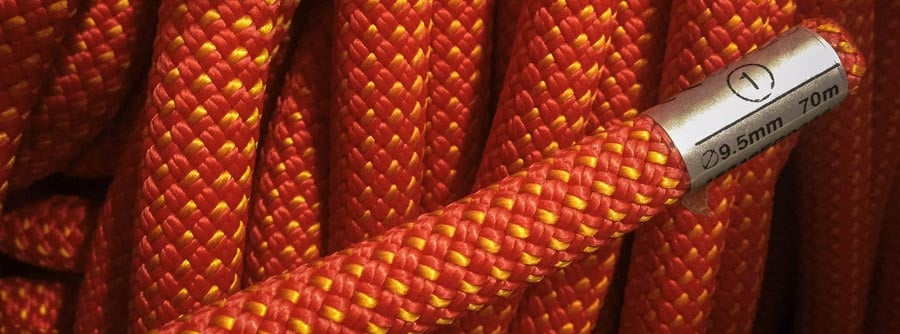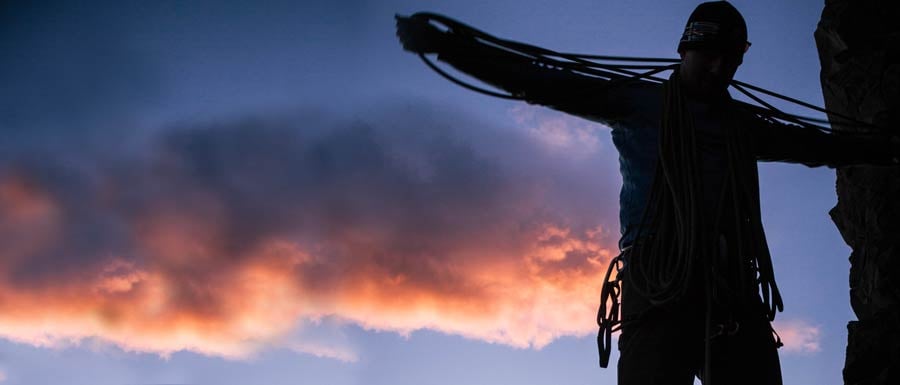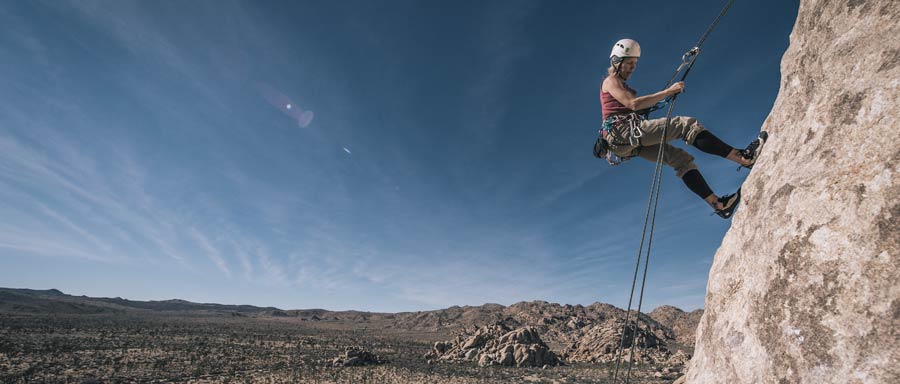If you're shopping for a climbing rope, there are four main considerations:
Rope type: The choice between single, half, twin and static ropes depends on what type of climbing you do.
Diameter and length: The diameter and length of a rope affect the rope's weight and durability and largely determine its best use.
Rope features: Features like dry treatments and middle marks affect how you use the rope.
Safety ratings: Looking at these ratings while thinking about what type of climbing you will be doing can help you choose a rope.
Remember: Climbing safety is your responsibility. Expert instruction is absolutely essential if you're new to climbing.
Types of Climbing Ropes

There are two main types of ropes: dynamic and static. Dynamic ropes are designed to stretch to absorb the impact of a falling climber. Static ropes stretch very little, making them very efficient in situations like lowering an injured climber, ascending a rope, or hauling a load up. Never use static ropes for top roping or lead climbing as they are not designed, tested or certified for those types of loads.
If you are looking for a dynamic rope for climbing, you'll have three choices: single, half, and twin ropes.
Single Ropes
These are best for trad climbing, sport climbing, big-wall climbing and top roping.
The vast majority of climbers buy single ropes. The name "single" indicates that the rope is designed to be used by itself and not with another rope as some other rope types are.
Single ropes come in many different diameters and lengths, making them suitable for a wide range of climbing disciplines, and they're generally easier to handle than two-rope systems.
Some single ropes are also rated as half and twin ropes, allowing you to use them with any one of the three climbing techniques. It's important to only use a rope as it was designed and tested to be used.
Single ropes are marked with a circled 1 on each end of the rope.
Half Ropes
These are best for trad climbing on wandering multi-pitch rock routes, mountaineering and ice climbing.
When climbing with half ropes, you use two ropes. As you ascend, clip one rope to protection on the left and the other to protection on the right. When done correctly, this allows the ropes to run parallel and straight, thereby reducing rope drag on wandering routes.
Half ropes have a couple advantages and disadvantages compared to single ropes:
Advantages
- Half-rope technique reduces rope drag on wandering routes.
- Tying the two ropes together when rappelling allows you to go twice as far as you can with a single rope.
- Two ropes provide redundancy if one gets damaged during a fall or cut by rockfall.
Disadvantages
- Half ropes require more skill and effort to manage compared to a single rope due to the fact that you're climbing and belaying with two ropes.
- The combined weight of two ropes is heavier than a single rope. (However, you can share the load with your climbing partner by each carrying one rope.)
Half ropes are designed and tested only for use as a matching pair; don't mix sizes or brands.
Some half ropes are also rated as twin ropes, allowing you to use them with either technique. There are also some triple-rated ropes that can be used as half, twin and single ropes for maximum versatility. It's important to only use a rope the way it was designed and tested to be used.
Half ropes have a circled ½ symbol on each end.
These are best for trad climbing on non-wandering multi-pitch rock routes, mountaineering and ice climbing.
Similar to half ropes, twin ropes are a two-rope system. However, with twin ropes, you ALWAYS clip both strands through each piece of protection, just like you would with a single rope. This means there will be more rope drag than with half ropes, making twin ropes a good option for non-wandering routes. On the plus side, twin ropes tend to be a bit thinner than half ropes, making for a lighter and less bulky system.
Twin ropes share many of the advantages and disadvantages that half ropes have compared to single ropes:
Advantages
- Tying the two ropes together when rappelling allows you to go twice as far as you can with a single rope.
- Two ropes provide redundancy if one gets damaged during a fall or cut by rockfall.
Disadvantages
- Twin ropes require more skill and effort to manage compared to a single rope due to the fact that you're climbing and belaying with two ropes.
- The combined weight of two ropes is heavier than a single rope. (However, you can share the load with your climbing partner by each carrying one rope.)
Just as with half ropes, twin ropes are designed and tested only for use as a matching pair; don't mix sizes or brands. Some twin ropes are also rated as half ropes, allowing you to use them with either technique. There are also some triple-rated ropes that can be used as twin, half and single ropes for maximum versatility. It's important to only use a rope as it was designed and tested to be used.
Twin ropes have a circled infinity symbol (∞) on each end.
Static Ropes
These are best for rescue work, caving, climbing fixed lines with ascenders and hauling loads. Static ropes excel in situations where you don't want the rope to stretch, such as when you are lowering an injured climber, ascending a rope, or hauling a load up with the rope. Never use a static rope for top roping or lead climbing as they are not designed, tested or certified for those types of loads.
Climbing Rope Diameter and Length

Climbing Rope Diameter
Generally speaking, a skinnier rope is lighter. However, skinnier ropes can be less durable and require more skill to safely belay with. Thicker-diameter ropes can be more abrasion-resistant and often stand up better to frequent use. If you're top roping at the local crag, you'll probably want a thicker rope. If you're hiking long distances for multi-pitch climbs, you'll want a skinnier, lighter rope.
Single ropes up to 9.4mm: Ropes in this range are very lightweight, making them ideal for long multi-pitch climbs where weight is important. However, skinny single ropes are not rated to hold as many falls as thicker ropes, they are harder to handle and they tend to be less durable.
If you plan to do lots of top-roping or take repeated falls while figuring out the moves on a sport climb, choose a thicker rope.
Be aware that a skinny rope can move quickly through a belay device, so you need a very experienced and attentive belayer to climb with one.
9.5 - 9.9mm single ropes: A single rope in this range is good for all-around use, including trad and sport climbing. These ropes are light enough to take into the mountains yet durable enough for top-roping at the local crag. They're generally more durable than very skinny ropes and they are easier to handle.
Single ropes 10mm and above: Ropes with a diameter of 10mm and above are best for gym climbing, frequent top roping, figuring out the moves on sport routes and big-wall climbing. These styles of climbing can wear out a rope faster so it's wise to go with a thicker, more durable rope.
Half and twin ropes: Half ropes typically have a diameter of about 8 - 9mm, while twin ropes are usually about 7 - 8mm thick.
Static ropes: Static ropes have a diameter of 9 - 13mm, and are commonly measured in inches, so you may see the diameter stated as 7/16", for example.
Climbing Rope Length

Dynamic ropes for rock climbing range in length from 30m to 80m. A 60m rope is the standard and will meet your needs most of the time.
Outdoor climbing ropes: When deciding what length to buy, remember that your rope needs to be long enough so that half its length is equal to or greater than the route or pitch you'll be climbing.
For example, if a climbing route is 30m long, then you need at least a 60m rope to be able to climb up and be lowered back down off of an anchor at the top of the climb. Some modern sport-climbing routes require a 70m rope in order to lower to the ground.
Indoor climbing ropes: Shorter-length ropes, about 35m long, are commonly used for gym climbing because indoor routes tend to be shorter than outdoor routes. Again, be sure the length of rope is long enough to lower a climber.
Static ropes: Static ropes for rescue work, caving, climbing fixed lines with ascenders and hauling loads come in a variety of lengths and are sometimes sold by the foot so you can get the exact length you need.
If you're unsure what length rope you need for a particular climbing area, it's best to ask other climbers and consult a guidebook.
Climbing Rope Weight
The overall weight of a climbing rope is largely determined by the diameter and length. Generally, a skinnier rope will be lighter than a thicker rope, but core construction is a factor that can make a skinny rope heavier than a thick rope.
It's standard for weight of dynamic climbing ropes to be listed as grams per meter (eg. 58 g/m), making it easy to compare rope weight regardless of the overall length. Use the grams per meter number and the length of a rope to calculate a rope's overall weight.
Weight for static ropes is often given as weight per foot.
Climbing Rope Features

Look for these features when you are comparing climbing ropes. They can make a difference in performance and ease of use.
Dry Treatment: When a rope absorbs water, it gets heavier and is less able to withstand forces generated in a fall (the rope will regain all of its strength when dry). When it's cold enough for absorbed water to freeze, a rope gets stiff and unmanageable. To combat this, some ropes include a dry treatment that reduces water absorption.
Dry-treated ropes are more expensive than non-dry-treated ropes so consider whether or not you need dry treatment. If you primarily sport climb, a non-dry rope is probably sufficient since most sport climbers will pull their ropes and go home when it rains. If you will be ice climbing, mountaineering or multi-pitch trad climbing, you will encounter rain, snow or ice at some point, so choose a dry-treated rope.
Dry ropes can have a dry core, a dry sheath or both. Ropes with both offer the greatest moisture protection.
Middle mark: Most ropes include a middle mark, often black dye, to help you identify the middle of the rope. Being able to identify the middle of your rope is essential when rappelling.
Bicolor: Some ropes are bicolor, which means they have a change in weave pattern that clearly differentiates the two halves of the rope and creates a permanent, easy-to-identify middle mark. This is a more effective (if more expensive) way to mark the middle of a rope than black dye because dye can fade and become difficult to see.
End warning marks: Some ropes include thread or black dye showing that you are coming to the end of the rope. This is helpful when you're rappelling or lowering a climber.
Climbing Rope UIAA Safety Ratings

The Union Internationale des Associations d'Alpinisme (UIAA) is the international mountaineering and climbing federation that creates safety standards to which all climbing ropes must adhere. Independent labs are responsible for carrying out the tests. All dynamic ropes carried by REI pass the UIAA tests.
The packaging on dynamic climbing ropes lists the test results for UIAA safety standards, including fall rating, static elongation, dynamic elongation and impact force. Looking at these ratings while thinking about what type of climbing you will be doing can help you choose a rope.
Fall Rating
The UIAA tests ropes to see how many falls they can hold before failing. Lab falls create much greater force than most real-world climbing falls. Therefore, the fall rating is mostly a comparative value.
Single ropes are tested by dropping an 80kg weight onto the rope, half ropes are tested by dropping a 55kg weight on a single strand, and twin ropes are tested by dropping an 80kg weight on 2 strands. All single ropes and half ropes must withstand a minimum of 5 UIAA falls. Twin ropes must withstand a minimum of 12 UIAA falls.
All ropes that meet the UIAA fall rating standard are safe for climbing. A rope with a higher fall rating may mean that that rope will last longer than a rope with a lower rating. However, always inspect your rope closely after a severe fall and consider retiring it if any damage is detected.
Static Elongation
Static elongation, also called working elongation, is the amount that a dynamic rope stretches with an 80kg weight hanging from it. Elongation on single and twin ropes cannot exceed 10 percent of the total rope length and half ropes cannot exceed 12 percent.
Static elongation is important to consider when top-rope climbing, hauling gear and climbing fixed ropes with ascenders. Higher static elongation generally indicates less efficiency because energy is wasted through rope stretch.
Dynamic Elongation
Dynamic elongation is the distance the rope stretches during the first UIAA fall. Higher elongation equals a longer fall, so generally speaking, a lower number is better because less stretch may prevent a falling climber from hitting a ledge or the ground. However, less dynamic elongation means a higher impact force on the climber, belayer and gear. The UIAA allows ropes to stretch no more than 40 percent of the length of the entire rope.
Impact Force
Impact force is the amount of force in kilonewtons that is put on the falling weight during the first UIAA fall. A lower number indicates less force on the falling climber, the belayer and the gear. The higher the dynamic elongation, the lower the impact force.
Lower impact forces make for a soft landing on the rope when you fall, but with that usually comes greater stretch, which can be less efficient when top roping.
